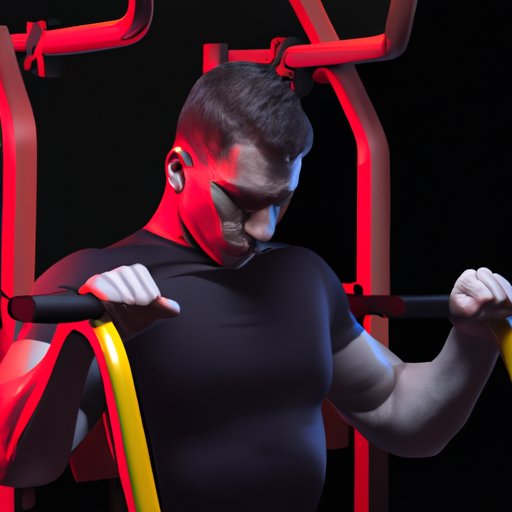
I. Introduction
Skullcrushers may sound intense, but they’re actually a great addition to any strength training routine. Not only do they target the triceps, but they also involve the shoulders, pecs, and core. In this article, we’ll cover everything you need to know about skullcrushers, including proper form, injury prevention, and different variations to try out.
II. The Ultimate Guide to Perfecting your Skullcrusher Technique
Before you start lifting heavy, it’s important to nail down proper form. Incorrect form can not only lead to injury, but it can also decrease the efficacy of the exercise. Follow these steps for a textbook skullcrusher:
- Lie flat on a bench with your feet planted firmly on the ground.
- Hold the barbell with an overhand grip and extend your arms straight up over your chest.
- Slowly lower the barbell towards your forehead, keeping your elbows in and hinging at your elbows.
- Pause and then lift the barbell back up to starting position.
Make sure to keep your elbows pinned to your sides and your core engaged throughout the exercise. Experiment with different weights and reps to find what works best for your fitness goals.
As for equipment, you can use a straight bar, ez-bar, or even dumbbells for skullcrushers. Choose what feels most comfortable for you and your fitness level.
It’s also important to note that there are different types of skullcrushers, including incline, decline, and close grip bench press skullcrushers. Each variation targets the triceps and other muscles slightly differently. Try incorporating different variations into your workouts to switch things up.
III. Avoiding Injury: Tips for Safely Executing Skullcrushers
Safety should always be a top priority while working out, and skullcrushers are no exception. Follow these tips to prevent injury:
- Warm-up: Spend 5-10 minutes performing light cardio exercises or dynamic stretches to get your blood flowing and your muscles ready for the workout.
- Use proper equipment: Make sure your bench is stable and supports your weight. Use collars to secure the weights on the barbell or dumbbells.
- Cooldown: Stretching after your workout can help prevent muscle soreness and tightness. Hold each stretch for 15-30 seconds.
- Avoid common mistakes: Don’t drop the weight too quickly or let your elbows flare out during the exercise.
IV. Maximizing Gains: The Importance of Progressive Overload in Skullcrushers
Progressive overload is a crucial component of any strength training routine. With consistent effort and a strategy in place, you can steadily increase the weight, reps, or sets of an exercise to build muscle and increase strength. Follow these tips to apply progressive overload to your skullcrusher routine:
- Track your progress: Use a notebook or an app to log how much weight you lifted, how many reps you completed, and how many sets you did.
- Gradually increase weight: As you feel more comfortable with the exercise, start to increase the weight by small increments (try 2.5-5 pounds at a time).
- Increase reps or sets: Once you’ve felt confident with your weight level, try adding more reps or another set to push your muscles harder and challenge yourself.
- Set goals: Whether it’s adding 5 pounds to your skullcrusher or completing an extra set, setting goals can keep you motivated to reach new heights.
V. Skullcrushers for Different Fitness Levels: A Comprehensive Guide
Skullcrushers can be modified to suit different fitness levels and goals. Use these workout routines as a guide:
Beginner Skullcrusher Workout:
- 3 sets of 10 reps with light dumbbells (5-10 pounds)
- Rest 60-90 seconds between sets.
Intermediate Skullcrusher Workout:
- 3-4 sets of 12-15 reps with moderate weights (10-20 pounds)
- Rest 45-60 seconds between sets.
Advanced Skullcrusher Workout:
- 4-5 sets of 15-20 reps with heavy weights (20-30+ pounds)
- Rest 30-45 seconds between sets.
Always make sure to use proper form and take breaks if you feel fatigued.
VI. Variation is Key: Exploring the Different Types of Skullcrushers
Adding variety to your workouts can help keep things fresh and prevent plateaus. Here are a few different types of skullcrushers you can try:
Dumbbell Skullcrushers: Hold a dumbbell in each hand and perform a standard skullcrusher with the dumbbells instead of a barbell. The extra stabilization required can add an extra challenge to the exercise.
Close Grip Bench Press Skullcrushers: Instead of lying flat on a bench, sit up and perform a close grip bench press. Lower the weight towards your forehead as you would during a standard skullcrusher.
Decline Skullcrushers: Lie on a decline bench and perform a standard skullcrusher. This variation can place more emphasis on the long head of the triceps.
Incorporate these variations into your workouts to target your triceps and upper body from multiple angles.
VII. Conclusion
Skullcrushers are a versatile and effective exercise for building upper body strength and increasing muscle mass. By following these tips for proper technique, injury prevention, and progressive overload, you can make the most out of your skullcrusher workouts. Remember to always modify the exercise to suit your fitness level and goals, and don’t be afraid to experiment with different variations for added variety.




